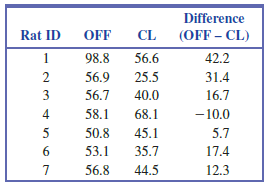New ?closed loop? (CL) devices have been developed to help to suppress overactive brain activity in patients
Question:
New ?closed loop? (CL) devices have been developed to help to suppress overactive brain activity in patients with conditions such as Parkinson?s disease and epilepsy (?Conceptualization and Validation of an Open-Source Closed-Loop Deep Brain Stimulation System in Rats,? Scientific Reports, April 21, 2015, nature.com/articles/srep09921, retrieved May 23, 2017). The CL device is implanted directly into a specific area of the brain, and one of the key advantages is that it can immediately apply a treatment in reaction to heightened brain activity. This may help to reduce the duration of seizures and other periods of uncontrolled movement in patients. A study was conducted on the effectiveness of the CL device on brain activity in rats. First, each of seven rats was observed for 15 minutes with the CL device implanted but not activated (OFF).
The percentage of the time that each rat was moving was recorded. Then, after each CL device was activated (CL), the percentage of the time that the rat was moving was recorded over another 15-minute period. The OFF and CL data values are approximated from a graph in the research article and appear in the table below, along with the calculated difference in movement, OFF ? CL.

a. Explain why two-sample t methods may not be appropriate in this context.
b. For purposes of this exercise, assume that these rats are representative of rats in general. Do these data support the claim that the mean difference in movement, OFF ? CL, is greater than zero? Carry out a randomization test to answer this question. You can make use of the Shinyapps in the collection at statistics.cengage.com?/PSO6e/Apps.html.
Step by Step Answer:

Introduction To Statistics And Data Analysis
ISBN: 9781337793612
6th Edition
Authors: Roxy Peck, Chris Olsen, Tom Short





